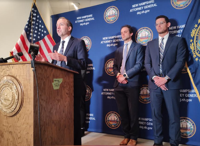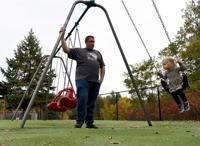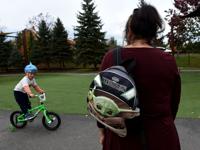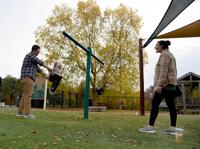Nature delivered glorious fall weather to New Hampshire last week, and the McRitchie family of Merrimack took full advantage of it.
At Nashua’s Roby Park, Andrew McRitchie was pushing 2-year-old Callum on a swing as his wife, Kathleen, looked on. Andrew is a clinical child psychologist who goes to work early at Massachusetts General Hospital; Kathleen is a nurse who works the night shift.
Getting outdoors with their son is a priority for these busy parents.
“We strive to have him playing outside at least once a day,” McRitchie said. “That’s really important to us.”
They also strictly limit their son’s screen time, he said — a video during a long car ride, a football game on in the background while they play.
Watching the joy on Callum’s face as he races around their yard or goes down the slide at the playground gives McRitchie all the feedback he needs, he said. “It makes me feel like a more successful parent.”
Kerri Szmyt of Pelham plays with her daughter, Hailee, 2, at Roby Park in Nashua.
DAVID LANE/UNION LEADER
At a time when social media companies are coming under scrutiny for adverse effects on children, public health advocates are promoting the great outdoors as a solution to problems ranging from obesity and chronic health conditions to social isolation and mental health troubles.
Patti Baum, program director at the New Hampshire Children’s Health Foundation, calls it the “antidote” to our high-stress, high-tech culture.
“Getting out in nature helps regulate what the body is built to do,” she said. “It doesn’t take away what may be some of those stressors in life, but it does help ameliorate some of that.”
Nearly 20 years ago, her foundation began funding programs focusing on childhood obesity that encouraged families with young children to get outside and walk and play. They noticed a trend.
“With the onslaught of availability of entertainment through screens, it really coincided with this explosion of childhood obesity,” Baum said.
They observed social effects as well, she said: “The isolation that comes from looking at a screen on your own, and losing the ability to interact not only with other children your own age but people of all kinds.”
Baum said she has seen the difference during her lifetime. When she was young, she said, kids learned how to interact with each other through outdoor play: “Figuring out the rules with other people, what’s fair and what’s not.”
“This is the piece that is lost, and I think can lead to not having the skill set to interact, in a way, to problem-solve with people, and talk through ideas, what’s working, what’s not.”
Excessive use of technology by children is a growing concern.
Last week, New Hampshire was among 40 other states and the District of Columbia to file suit against Meta, alleging the company designed its platforms Facebook and Instagram to entice and addict children.


Attorney General John Formella spells out the state’s lawsuit against Meta, the world’s largest social media company, during a news conference Tuesday in Concord. Behind Formella are, at right, Senior Assistant Attorney General Brandon Garod and Assistant AG Kevin Scura.
Kevin Landrigan/Union Leader
Design features intentionally built into the popular platforms “work together to exploit the development vulnerabilities of children and trap them into never-ending use that the social media giant knows harms their mental health and well-being,” the Attorney General’s Office said in a statement.
The lawsuit comes two years after New Hampshire joined a nationwide investigation into how use of these platforms may be linked to an increased risk of harm, including depression, eating disorders, and even suicide in youngsters. That investigation has since been expanded to include similar conduct by ByteDance, owner of Tik Tok, Inc.
‘Pathways to Play’
Baum recently brought her new puppy with her to visit a relative in the hospital. As she was leaving, she noticed a mother and young child waiting near the elevators.
The mother tried to get her daughter to look at the small, wriggling puppy. “This child would not look up from the screen,” Baum said.
For Baum, it felt consequential.
Her foundation offers grants to regional planning groups to create what they call “pathways to play.” The idea is to help communities expand and promote recreational spaces where families with young children can play outdoors.
The Greater Nashua area was first to embrace the idea.
Ryan Friedman, the senior GIS (geographic information systems) planner at Nashua Regional Planning Commission and part of the team that developed the grant project, said they wanted a “data-driven approach,” he said.


Andrew Szmyt of Pelham watches as his daughter, Hailee, 2, plays on the swings at Roby Park in Nashua.
DAVID LANE/UNION LEADER
So the planners did an inventory of existing resources such as parks, playgrounds, open space and trails in all 13 communities in their region, and computed how many kids live within a certain distance from each. “We really tried to look at walkable and bikeable opportunities,” he said.
From that, they published an interactive “story map,” with photos and details about each resource that people can click on. The original 2017 map was updated earlier this year with photos and information about more sites.
The team also created a planning document that communities could use when considering new playgrounds, trails or parks.
“There are things to think about in terms of equity and location, making sure that the right people are using it, that it’s in the right place,” Friedman said. “We really want towns to be thinking about that.”
Offering an alternative
Jen Czysz, executive director of the Strafford Regional Planning Commission, previously worked at the NRPC and was involved in the “pathways to play” project there. When she started working at the SRPC, she wanted to replicate the project for that region.
When they surveyed residents in their 18 communities, which include Dover, Rochester and Lee, Czysz said, “We found that folks didn’t know that there were certain recreational facilities close by.”
So they launched POP, Promoting Outdoor Play, to let area residents know where to find fields, playgrounds, parks and trails in surrounding communities, with an interactive story map and photos that highlight features.
They also did a pilot project in Somersworth, where they got kids involved in designing their ideal parks, and set up birdhouses at recreational sites where kids could visit to get their passport stamped.
The project’s timing turned out to be fortuitous, Czysz said. The pandemic hit — and people started going outside.
“Our communities were seeing a massive uptick in recreation use and a great interest and reinvestment in outdoor recreation,” she said.
Czysz agrees that playing outdoors can be the antidote to the metaverse.
Studies have shown that loneliness is increasing, she said. “They talk about how the more we use our smart devices and the more we’re theoretically connected through the metaverse, we’re actually further segregating ourselves,” she said.
Nature offers a way and a place to connect, she said. “It’s getting outside, it’s enjoying the fresh air, it’s meeting new people, it’s being out in your community, it’s being active,” Czysz said.


Mary Overko of Nashua watches her grandson, Sebastian, 4, ride his bike at Roby Park in Nashua.
DAVID LANE/UNION LEADER
Starting early
Southern New Hampshire Planning Commission, which serves 14 communities including Manchester, Derry and Windham, recently got a New Hampshire Children’s Health Foundation grant for a Pathways to Play project.
“This is putting planning for recreation on our radar in a way that it hasn’t been before,” said Suzanne Nienaber, principal planner at the commission. “I really think finding ways to integrate play and movement and outdoor activity into our daily lives is incredibly important.”
They have done a regional survey, asking people about opportunities and barriers to play, and they plan to create an interactive map to let area residents know what’s available.
“The public health research really indicates that having access to well-maintained, clean, safe, welcoming play spaces can make a big difference in terms of our mental well-being,” Nienaber said.
It’s critical to start young, she said. “”You want to instill healthy habits very early in life,” she said. “We want that to become part of kids’ daily habit.”
New Boston was chosen for a pilot project.
Mike Sindoni, New Boston’s recreation director for the past 20 years, is enthusiastic about what his community can do to make recreational facilities more connected and accessible for everyone. The idea is to create a loop through the village, connecting the library, school, ballfields and playground, even the rail trail where bikers can make their way to the Fisher Cats’ stadium in Manchester, he said.
What has to happen to make that a reality? “Well, money,” he said.
They would need to put in crosswalks to make it safer and create pathways that are accessible to everyone — kids in strollers, seniors with walkers and individuals who use wheelchairs.
Like others, Sindoni said things are different from when he was a kid. His department runs an after-school program, and it can be a struggle to get some kids off their phones and outside to play, he said.
“It’s a different world,” he said.
Sindoni is hoping the town’s embrace of the pilot project will change things.
“Something like this maybe opens people’s eyes,” he said. “Hey, there’s a lot of things in this little town of ours, and if we can connect them a little better and a little safer, it might be more appealing to people to maybe get out more and do more stuff in town.”


Andrew and Kathleen McRitchie of Merrimack play with their son, Callum, 2, at Roby Park in Nashua. The couple say they make sure the toddler plays outside every day.
DAVID LANE/UNION LEADER
Changing behavior
Planners say recreation fields have become the new town square for families with children. So it makes sense to interconnect these resources and make them more accessible to everyone.
“If we think about community and building that vitality that we cherish in our communities, our recreation facilities are key to that,” Czysz from the Strafford commission said. “If we can get families out walking and playing and engaging in their community, it just has a lot of great benefits for everyone.”
Her dream is to see these sorts of projects replicated statewide, with regional maps linked together. That would benefit not only local residents but the state’s tourism industry, she said. “It’s really just promoting New Hampshire and our communities as a great place to live and play,” she said.
In a state with an aging population, attracting and keeping young people here is also an economic priority, Friedman from the Nashua commission said.
“Anything that you can do to make it more enjoyable for families is clearly at the forefront of everyone’s mind,” he said.
When it comes to getting more people outdoors, the Children’s Health Foundation’s Baum said she hopes the adage is true: If you build it, they will come.
But she said, “We’re very realistic. Changing people’s behavior is one of the most difficult things to do.”
Both as a clinician and a dad, Merrimack’s Andrew McRitchie worries about the effects of technology on youngsters’ development.
Those quick videos kids like to watch online seem to be having an effect on their attention spans, he said. “The ability to sit and pay attention to something for a long period of time is gone,” he said.
There’s also growing evidence of a link between very young children’s screen time and ADHD, he said.
As kids get older, moderation is key, McRitchie said. “If you eat McDonald’s every day for a meal, you’re not going to be healthy. If you eat it once in a while as a treat, no big deal,” he said.
It’s the same with technology and kids, he said. “There are times it can be a useful tool, but when it’s the only tool in the toolbelt, it starts to become problematic.
“They start to develop connections with their screens and not with people.”
For photos and information about recreational opportunities:
This news is republished from another source.

































